Luc Van Lierde on lactate testing
Endurance Events and Lactate Testing
With Emphasis on the Triathlon
19 of 19
How best to use heart rates in training
Heart rates are a very useful technique to estimate stress on the body and muscles during exercise. Since Polar introduced their heart rate monitors in the 1980's, thousands of research studies have been done analyzing the validity and advantages of using heart rates in different aspects of training. In 1987 Polar published a book, "Training Lactate Pulse Rate" (see image of book cover below) that tried to establish the validity of using heart rates for training comparing it to lactate which was considered the standard. If heart rate monitors were to have a future in the training world, it was first necessary to correlate heart rates with lactate.
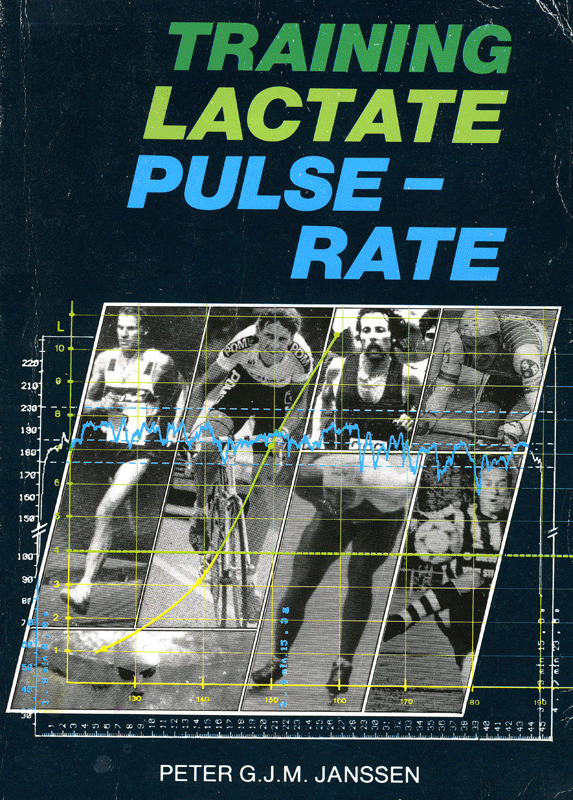
The use of heart rates in training is very popular. They are simple to understand, relatively inexpensive and non invasive. In the 1980's and 1990's lactate tests were very expensive, required a blood drop and only the scientists seemed to know what it meant. Only those with access to expensive lab instruments and the technical knowledge of energy metabolism could use lactate testing. Today athletes are routinely guided in their training by heart rates but the lactate test that was only available to the elite is now an option for any athlete that wants to optimize his or her training. Our point of view is obviously biased in that we believe that heart rates if used correctly are excellent training aids but are limited in what they can do.
What heart rates can tell you. What heart rates cannot tell you.
Heart rate information is an excellent indication of the general fitness of an athlete. Changes in heart rates will also indicate other stresses that are affecting athletes and their training, including impending illness and fatigue. Thus, heart rate testing is a very useful parameter for monitoring the reaction of the athlete’s body to training and its interaction with the environment. Unusual heart rates are an indication that the body is being affected adversely by other variables (such as fatigue, diet, infections or environmental variables like temperature, rain and altitude). Normal heart rate response tells the athlete that the training and the body are in harmony.
Heart rates are therefore a good measure of whether the body is accepting the workout and will adapt as desired. It is impossible to measure all the variables that will affect a workout. If the heart rate response is normal, it means that the body is probably responding as expected. An abnormal heart rate response is a red flag, suggesting that something is probably interfering negatively with the training.
Recently, much research has been done with heart rate variability (HRV), which also can be a measure to alert the athlete and coach to possible problems. It would lead us to far astray from the topic of lactate testing to explain HRV in detail, but since this measure may become very important in the future, herewith is a short description. HRV reflects the variability in time period between 2 heart beats. Our heart rate depends on a “fight” between 2 components of our autonomic (out of our control) nervous systems: the parasympaticus and orthosympaticus. A low degree of variability is not a good sign since it reveals a weak input by one of the components. Detail analysis may quantify the misbalance between both components and tell the coach whether a training program runs a risk and how high the risk is. At this moment this training monitoring procedure is used mainly for elite athletes but it is clear that this procedures will in the future be available for athletes of different capabilities.
It was pointed out that heart rates can be very useful in cycling for controlling intensity on the bike during a training session or during competition. The athlete should combine this with the feeling they have correlated with lactate readings and between the two and power settings will enable control over the workout. While extremely useful for the control of cycling intensities it is also very valuable for the monitoring the response of the body to training. Heart rates have many uses but some limitations when applied to an overall workout or a training program.
Risks with using heart rates for training
The use of heart rates to guide training lacks scientific validity. Many have tried to relate heart rates to the metabolic characteristics of a specific effort or exercise. There is no doubt that heart rate increases when an athlete works harder, but the physiological significance of a given effort can not be deduced by means of heart rate monitoring.
- Heart rate cannot provide information about aerobic and anaerobic capacity performance.
- Heart rate cannot provide information about the aerobic and anaerobic contribution of a training exercise.
- Heart rate can not accurately characterize different types of exercises/sets within a training session (it provides only an approximation.)
- Changes of heart rate over time at the same effort don’t tell you what the underlying physiological adaptation is.
- Heart rate therefore does not allow for an accurate assessment of the training effectiveness over time and thus cannot tell the athlete or coach which aspects of a training program are having a positive or negative influence on training adaptation.
- Heart rates can be used to control training especially while cycling and non track running. Heart rates should be supplemented with a control test occasionally to make sure the intensity is what is desired and we have provided some examples of using heart rates to indicate proper training intensity.
- A popular training philosophy is to use training zones. Sometimes the difference between one end of a training zone and the other is as much as 15 bpm. The training literature often leaves the coach and the athlete with the impression that the same training effect will take place no matter where the athlete is in the particular zone. However, the training effect on the body could be very different at the low end of the training zone from that which will take place at the high end. An example below indicates that even a difference of only 8 bpm represents two completely different training effects.
Evidence for these statements comes from several studies. Some examples that have examined heart rate and training are below.
Conconi Test
There is no evidence that one of the most popular heart rate tests, the Conconi test or the Conconi deflection point, represents the MLSS. As shown in the next graph, the speed at the Conconi deflection point (Conconi threshold) differs clearly from the lactate threshold for this group of runners (if both thresholds would be identical, then all points have to be located on or near the diagonal line in the graph). Similar results were found for swimming and cycling even when the new adjusted Conconi test was considered in the study.
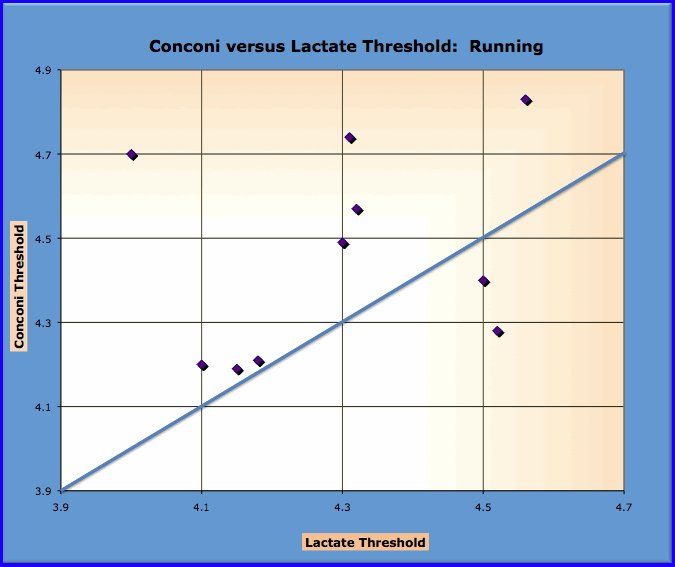
Cyclists were asked to perform 30 minutes constant efforts at 100, 90, 80, 70 and 60% of the Conconi threshold. Lactate was measured several times during each effort in order to verify whether or not the athletes attained a lactate steady state. When the 30-minute constant load pace was between 60 and 70% of the Conconi threshold the lactate levels were between 1.5 and 6 mmol/l and every athlete maintained a lactate steady state. At a work load between 70 and 80% of the Conconi threshold, lactate readings were between 2 and 9 mmol/l. However, 36% of the athletes were unable to maintain a lactate steady state. This means that 36% of the athletes had surpassed their lactate threshold but were still well below the Conconi-indicated threshold. The percentage of athletes that were not able to work at a lactate steady state increased further to 52 and 83% when the workload was set at 80-90% and 90-100% of the Conconi threshold respectively. The obvious conclusion is that the Conconi threshold is not a maximum steady state lactate level for most athletes.
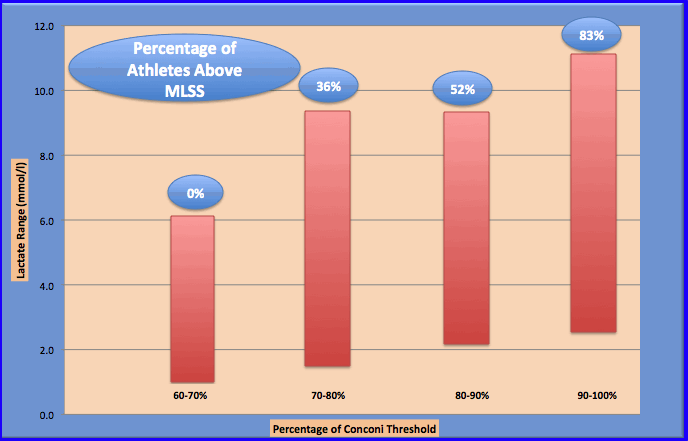
Heart Rate vs Lactate - The following chart indicates why it is not possible to identify the energy contribution of the different systems by heart rate. A small range of differences in heart rate can correspond to large differences in physiological significance of the effort. An elite runner was asked to run 5 different 28-minute workouts at a constant speed. Each 28-minute run was done at the same time on different days and at different speeds. Environmental conditions were identical since the runs took place on a treadmill in a lab. Between the least intensive (easy) and most intensive (hardest) load, we observed a difference of only 9 beats/min, corresponding to a lactate difference of 5 mmol/l. This narrow range of heart rates corresponded to dramatically different contributions by the aerobic and anaerobic energy systems.
A more dramatic way to look at this is that for a 5% change in heart rate there was a 250% change in lactate.
The initial speed for this test produced very low lactate levels but is the equivalent of a 2:20 marathon (average of 5.0 m/s, which is 5:20 per mile or 3:20 per kilometer). This athlete could probably hold this pace or a faster pace for an extended period of time. However, for a pace that is only 9 heartbeats higher this athlete will be forced to stop in just over 20 minutes (5.6 m/s or 4:46 per mile or 2:59 per kilometer). A small difference in heartbeats per minute represents dramatic changes in metabolic processes. Thus, the athlete must use other guidelines to control his training and race pace. The better the athlete, the more likely this will be a problem. In a highly elite athlete, the maximum lactate steady state pace gets very close to VO2 max. And the heart rate changes very little close to VO2 max. So the lactate values and metabolic processes in the muscles change very rapidly with little corresponding change in heart rate.
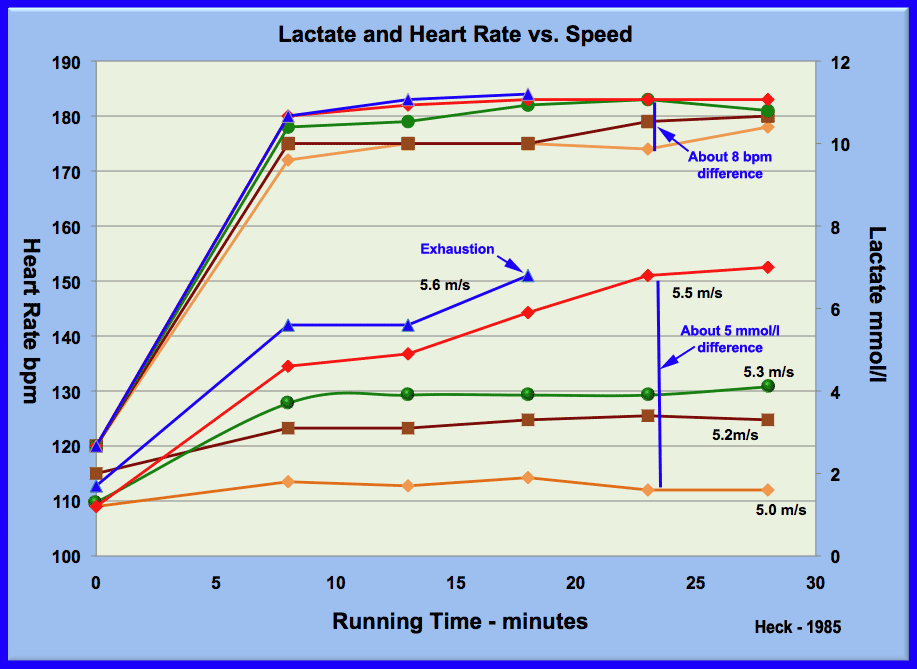
Also non-physiological factors such as weather or surface affect heart rate (easily ±6 beats). It is clear that the determination of training intensity by heart rate is very unstable and variable and therefore not accurate and reliable.
The following table shows a reduction of about 4-6 beats per minute for low workloads (<4 mmol/l) on woodlands and a cinder track if the track is wet, compared to the same workload on a dry track. This means that there is a difference in physiological significance of training at the same heart rate in wet or dry weather for these two surfaces. This is probably due to better cooling of the body in the wet weather.
The decrease in heart rate in the wet environment disappears if the exercise is performed on grass. The fact that the athlete has to be more attentive when running on wet grass probably obviates the benefit of a better cooling environmental condition. The increase in the heart rate on the wet grass was probably due to an increased mental stress from running on a slippery surface.
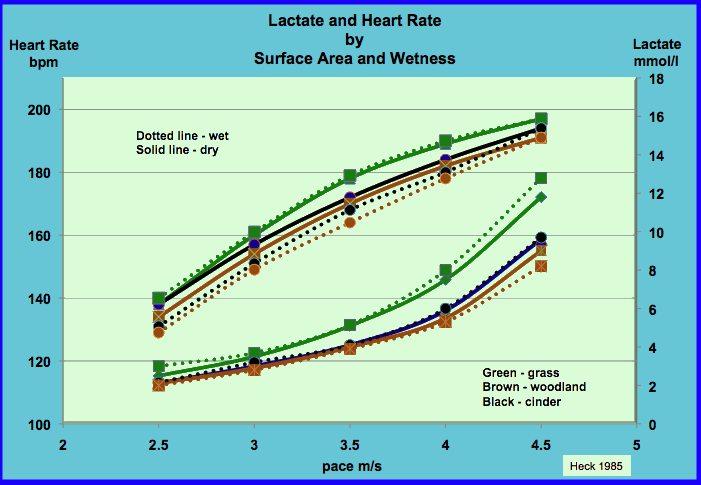
These findings are not unusual since heart rate reflects much more than just the demand for oxygen by the muscles.
- During exercise, heart rate is also driven by many processes that protect the body. For example, heat is a danger linked with endurance sports. The body reacts to heat by increasing the circulation of blood so that it can be cooled down better when more blood reaches the skin. Hence the heart will beat faster to move the blood to this relatively cooler part of the body. This is extremely noticeable during the first days of warmer weather.
- Another stimulation of heart rate comes from stress. Stress can be positive since it prepares the body to perform at a higher level. But it can also be negative if this stress originates from a catabolic origin (disturbing/destructive) such as illness, pain, overloaded muscles, non-homeostasis etc. In such a catabolic situation, even the best training program will cause your conditioning to deteriorate rather than build up. It is therefore very important to detect this catabolic status as soon as possible and to reduce or halt your training program immediately. Consequently, heart rate observations, such as morning heart rate, heart rate at standard intensities, maximal heart rate and recuperation of heart rate, are very useful observations to assess whether you should cut back on your training program.
Despite all these extraneous factors affecting heart rates, endurance athletes depend heavily on heart rate monitors to tell them how their body is being stressed. Heart rates are especially useful in cycling when there is little external cues to tell the athletes how intensely he is exercising and each ride is affected by wind and weather. In a swimming pool there is no need for heart rates as one's pace is easily calculated and there are no changes in altitude. Running is less problematic than cycling as one can use a track or fixed course to estimate pace but many triathletes like to use woodland trails for training. Near our offices is the Pocantico Hills and it is not uncommon to see world class athletes running on the hundred miles of hilly trails that are available there. So heart rate monitors have become a second check on what the body is doing. One's physical perceptions should be the first. However, the athlete should be aware of the limitations of using heart rates especially at high intensities near the threshold.
This second characteristic of heart rate is used in the next section to show how an athlete can help read his body by monitoring his morning heart rate.
Opportunities to use heart rate for training
Despite the limitations of heart rate monitoring mentioned above, a heart rate monitor has many valuable uses. We mentioned above that heart rates are the best measure of the body’s reaction to a workout. Consequently a triathlete should continually record heart rate information as part of the training log in order to compare responses over time to training and the environment.
The chart below shows how a heart rate monitor can be used to tell if the body of the athlete is ready to react constructively to training. The morning heart rate (MHR) was measured before, during and after three different training camps at altitude. (Morning heart rate is measured 1 minute before leaving your bed - this to avoid the influence of respiration on a low heart rate) The chart indicates that:
- During the first days of arrival at altitude, this athlete’s MHR increased compared to his MHR at sea level. The higher the training camp, the longer it took before MHR became comparable with the normal MHR at sea level.
- An upper respiratory tract infection was indicated by MHR 4 days before symptoms of the disease were observed (middle chart). During the days before the infection was observed we could not known the reason for the catabolic signal but training was reduced in order to give the organism more room to overcome this internal problem. The athlete returned to good health sooner than if he had continued training and only stopped when the infection was diagnosed by more traditional symptoms.
- Also an accumulation of fatigue due to training can be the cause for a rise in MHR. But once again, even if we didn’t know the reason for this catabolic status of the body we still reduced training.
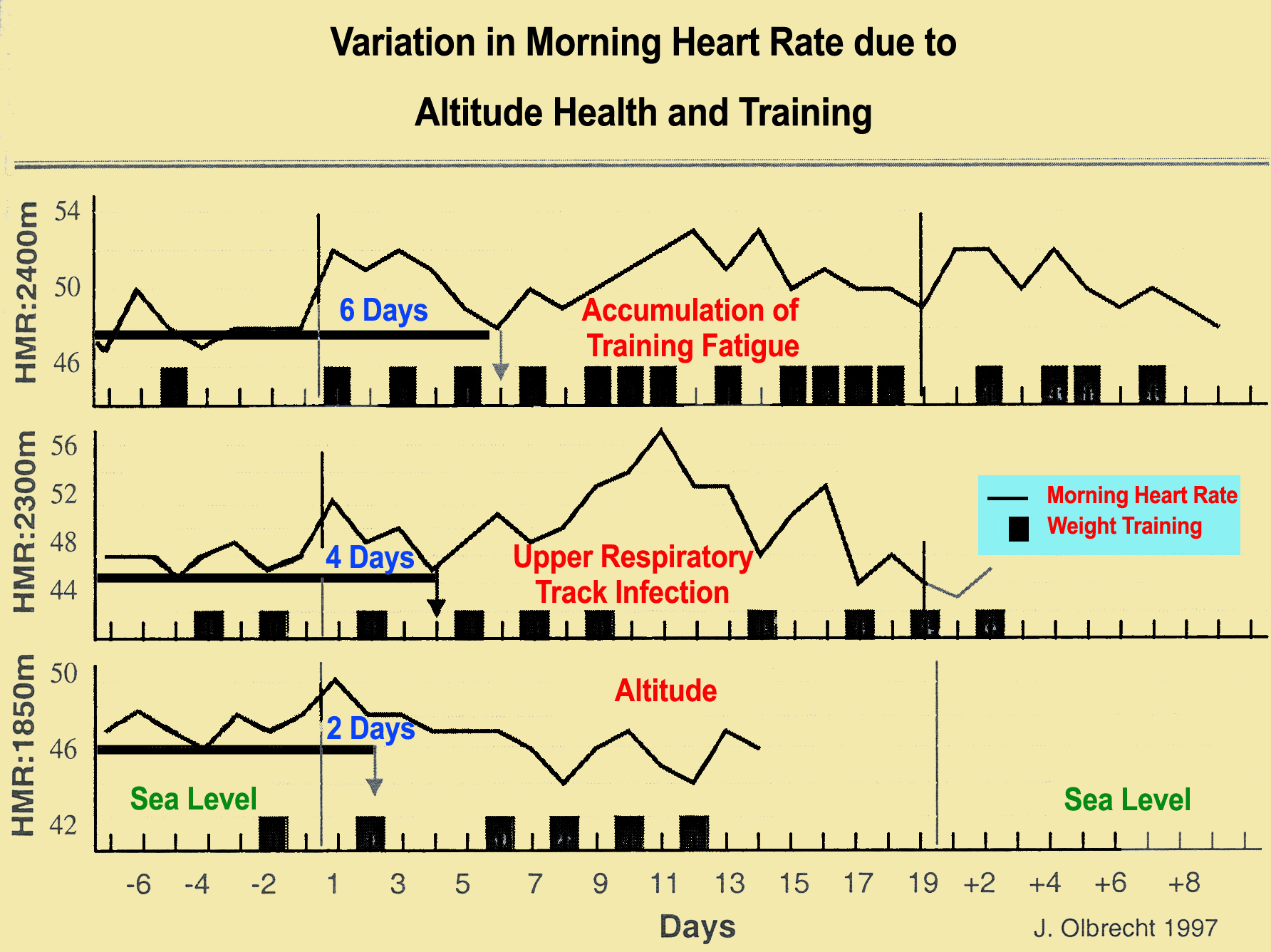
Heart rates and lactate are two very different measures of the body’s reaction to exercise. Lactate reflects what is happening in the muscles and is the best measure of the development of the muscle’s energy systems. Heart rates are a much better measure than lactate of the body’s overall fitness and reaction to training. You can use the analogy of a thermometer and a barometer. Both are measures of the weather but they tell you very different things. Together they provide the weather forecaster with much more information than either one alone. However, if you used one to replace the other you will sometimes get the right information, but more often than not you will make a mistake. Often the mistake can be costly.
In the future we will add additional information to enhance the reader's understanding of specific topics.
